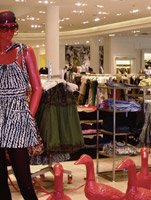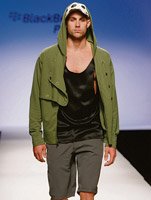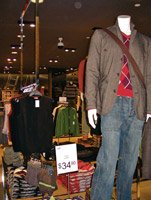Is Fast Fashion Setting the Pace?
It’s been a long time coming, and now that it’s here, fastfashion retail is changing the way California’s retailers and apparel makers do business.
As trendy as the skinny jeans and mod tops that hang on their racks, fast-fashion retailers—from European imports H&M and Zara to home-grown chains Forever 21 and Wet Seal—have taken the state by storm in the last year. Luring shoppers with a one-two punch of cheap and timely designer knockoffs and throw-away fashion, H&M opened seven California stores last year (with several more scheduled to open in 2007), and Forever 21 opened a giant flagship store and a new concept shop and launched a men’s collection. California chain stores Wet Seal and Charlotte Russe have skewed their formats to emulate the fast-fashion model of near-daily deliveries and uber-trendy offerings. And lesser-known European retailers Zara and Mng by Mango are making a play for a piece of the West Coast retail pie, as well.
Thrilled at the prospect of finding “it” fashion on the cheap, California consumers are welcoming fast fashion. Last November’s grand opening of H&M at the Beverly Center in Los Angeles drew more than 900 people, and the giant new Forever 21 store in Pasadena, Calif.’s Old Town district drew hordes of eager juniors shoppers. But it isn’t just the pennywise shopper who opts for fast fashion. Consumers who regularly frequent boutiques and specialty stores aren’t shy about popping into a fast-fashion spot for a sexy top or runway-inspired piece.
“There is definitely a girl who’ll still spring for the $200 jeans at a high-end boutique and pick up a little something at H&M—right now it could be a striped T-shirt or little dress,” said Tadd Zarubica, owner of the premium-denim brand Denim of Virtue. “It’s cool to mix the high and the low— especially in L.A.” It’s this crossover customer that has some contemporary designers and retailers a little jittery.
Cheap vs. chic
“It’s not about competing with them on price—it’s about the look and time to market,” said Freddie Rojas, owner of the Rojas brand of contemporary womenswear and menswear, which sells at Intermix, Planet Funk, Metropark and Diavolina, as well as at his own Melrose Avenue store in Los Angeles.
William Anzevino, co-designer of the quirky Los Angeles–based contemporary brand Anzevino & Florence, agreed. “Buyers are responding to the most exclusive and obscure pieces. They want something that’s not going to end up in H&M. So we’re forced to be more creative and experimental.”
City of Industry, Calif.–based retailer Metropark works with brands to create exclusive looks for its stores. “Not to make things cheaper but to make them special,” said Renee Bell, vice president of merchandising and general merchandise manager.
Some manufacturers take the “if you can’t beat them, join them” approach to competing with fast fashion. Gloria Brandes, owner and designer of the young contemporary brand B.B. Dakota, employs some of fast fashion’s own techniques to get the right look.
“I’m a big advocate of waiting until the last minute to commit to final designs. I commit early to fabrics and update the styles and trims as we get closer to market,” she said. Stocking ready-to-dye fabrics and putting styles into production in the 11th hour is “precisely what Zara does,” she said. “I’m not afraid of adding 25 percent of my line closer to market, because the newest information is often the best.”
Local designers also compete by offering styles in fabrications that are out of reach for fast-fashion makers. “I need better trims and construction to compete with H&M,” said Rojas, whose latest collection includes long empire-waist hoodies for women and plaid bomber jackets for men. Anzevino said he and his business partner, Rich Florence, have upgraded their fabrics, technology and details. “Buyers want little details that make it feel like a luxury item—down to the zipper,” he said.
Ilse Metchek, executive director of the California Fashion Association, said fast fashion may have the speed and the depth, but contemporary brands have the fit, the quality and the vision. “Designers have to focus on creating fashion that is not going to be out of style in 10 weeks. There is a trend in the contemporary market toward a ’cultured’ look—things with special details that can’t be produced if you’re going to throw it away,” she said. “That’s why pieces such as cashmere sweaters, which scream ’quality,’ are so hot right now.”
Speed-to-market
Consumers wandering the aisles of fast-fashion shops see an ever-changing array of goods on a near-daily basis—making contemporary retailers look stale by comparison. While most specialty retailers can’t keep up with that breakneck speed, many are beginning to ask for more deliveries and a quicker turnaround on their orders.
With every one of its 24 stores sharing a shopping center with at least one fast-fashion store, mall-based Metropark is on the fast fashion vs. contemporary front lines. Bell, the chain’s general merchandising manager, said Metropark’s strategy is plenty of legwork and weekly and daily shipments from a wide array of brands. “We’re constantly looking at new and existing lines. We hit all the trade shows and have appointments weekly to see new goods. We really work to have new weekly shipments in every department,” she said. “As much as I need to know what Forever 21 is up to, I need to make sure my mix is more sophisticated, with better quality and more detail.”
Contemporary stores may have more distance, but they are also keen on keeping a similar sense of freshness—and they’re enlisting the help of contemporary brands to do it.
“The focus is definitely on shorter delivery times and more deliveries,” said Michelle Kim, owner of the young contemporary 213 Industry brand and the contemporary knits line MK2K. Kim, who manufactures in Korea for the cost benefits, air freights all her goods to Los Angeles to save some time. “It’s the only way. I can’t risk having my stuff stuck on a boat somewhere,” she said.
Rojas, who manufactures in Los Angeles, has upped his deliveries to once every two months and said he begs his contractors to help him turn orders around in half the time it took just a few years ago. “They’ll do it, but it is getting to be a game,” he laughed.
Brandes—who sells B.B. Dakota to retailers such as Macy’s, Nordstrom and Urban Outfitters— said she is also feeling pressure to speed up her manufacturing. “It used to be that I had 90-day lead times. Now it has to be closer to 60 days,” said Brandes, who carries inventory to accommodate buyers in need of Immediate goods. With some of her production done domestically, the challenge isn’t as great as it could be, she said.
Some retailers sidestep the issue of faster turnaround by focusing on finding Immediate goods. “At markets we try to show what is shipping in six months, but our customers want to see what we’re shipping in six weeks,” Anzevino said. 213 Industry’s Kim noticed that buyers who focus on trendy items “still go to all the shows, but they don’t necessarily place orders. They get a sense of where the market is going and place orders at the last minute. That’s why I think fast fashion is definitely going to affect the trendier boutiques. It’s just so hard to keep up.”
Despite the new stresses the influx of fast fashion is putting on California’s retailers and manufacturers, there are those that welcome it. The need for speed has some in the industry speculating that brands with overseas manufacturing will bring their production back to the United States in order to cut down on lead times—something that bodes well for Los Angeles’ shrinking manufacturing industry.
Jennifer Evans, owner of the Evans Group production house in Los Angeles, said she saw some of her clients opt for less-expensive overseas manufacturing, only to have them return a few seasons later. “China is definitely an attractive market—but the costs are very similar when you factor in things like shipping,” she said. Other factors that sent brands running back to Los Angeles are quality-control issues, difficulties sourcing and the inconvenience of “doing business in the middle of the night because of the time difference,” she said. To accommodate her increased business, Evans has added a second shift.
Some of Evans’ clients, which include Society for Rational Dress, Grey Ant, Jeremy Scott, Geren Ford, Trasteverine and Magda Berliner, have switched from seasonal production to smaller-volume monthly production. “It allows them to keep up with the trends and move more quickly,” she said. As more high-end stores attempt to continually refresh their selection, more brands might opt for this style of production, Evans said.
“It keeps us, as designers, on our toes. We’re trying new things and going out on limbs fashionwise. And, if fast fashion is bringing work back, I think that’s great for L.A.,” Rojas said.
Fast Fashion: Mathematically Speaking
Behind the frivolousness of selling trendy fashion to teenage girls and college co-eds, fast-fashion makers are well-oiled machines fueled by ingenuity and some fancy math. Zara, the Spanish manufacturer and retailer, has been the focus of study for the Harvard Business School and the Massachusetts Institute of Technology. Here is a quick peek into what they found:
The design process at Zara starts with its staff of 200 designers, who annually conjure up about 40,000 new designs for the company’s men’s, women’s and children’s lines. Market specialists help cull the number to 10,000 designs, which are produced in several colorways and five to seven sizes. The company produces its men’s, women’s and children’s line independently at its three parallel manufacturing facilities in Spain and separate design, sales and production teams usher the designs through the manufacturing process. Zara’s technique is costlier than having a single large staff producing all three collections—but it is much faster.
Because the designers share space with the production staff, they can smooth any difficulties on the fly, saving precious time. All the while, market specialists are gathering information from Zara store managers to learn what trends are checking. To keep all of this flowing smoothly, Zara uses custom technology, computers and cell phones. The result of good communication and relentless production: Zara can adjust its orders by 40 percent to 50 percent once the season has started, resulting in less overproduction and the ability to chase trends as they occur.
























